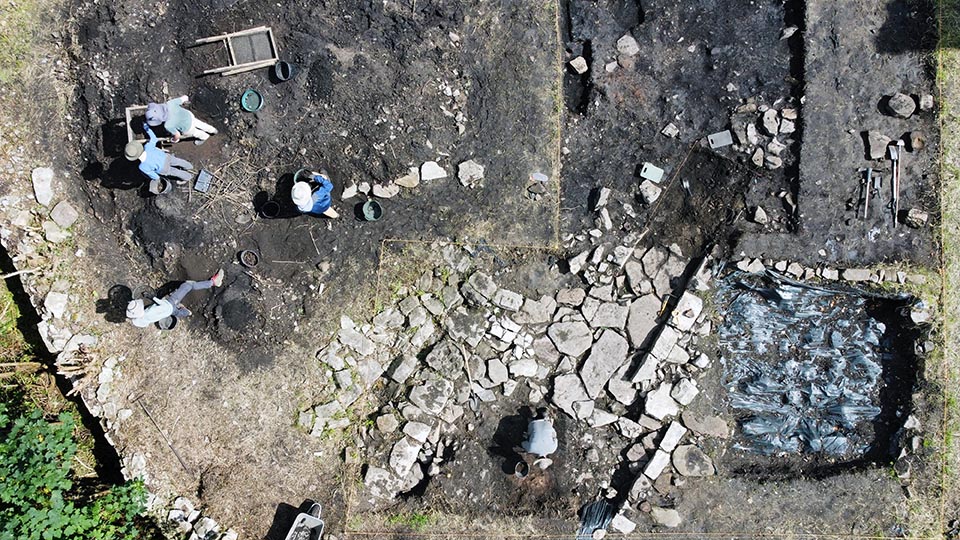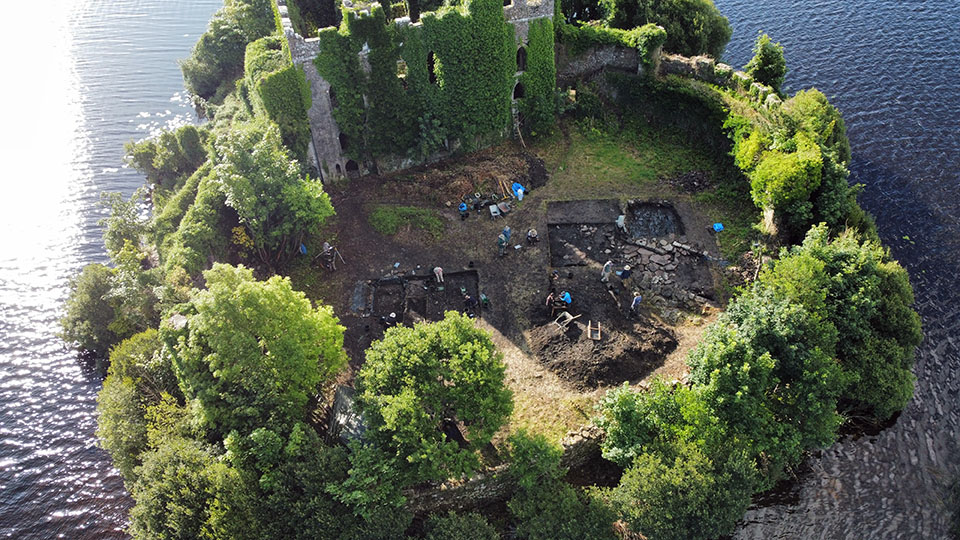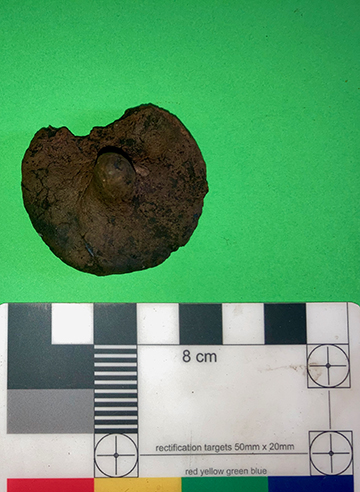Finan Wraps Up Phase I of Rock of Lough Key Excavations
01/22/2024
Thomas Finan, Ph.D., associate professor in history, has officially wrapped up the first phase of a project he started back in 2019.
Finan said his project in north County Roscommon, Ireland on the Rock of Lough Key, the medieval castle of the MacDermot lords of Moylurg, keeps surpassing expectations.

Excavation work being done on the newly discovered medieval entrance feature on the Rock. Photo submitted.
“Last year, my colleague Sam Moore said that we completed a mighty campaign, and when he returned this summer in a visit of the Royal Irish Academy’s National Committee on Archaeology, he said, ‘Tom, somehow you managed to do it again,’” Finan said.
The project began in 2017 when Finan led a team that discovered extensive remains of medieval settlement on Castle Island, the castle of the MacDermot kings of Ireland in the summer of 2019. The COVID-19 pandemic derailed plans to return until 2022. For 2023, Finan and his colleagues John Soderberg of Denison University and Jim Schryver of the University of Minnesota Morris returned to the site. Despite having to battle daily monsoon downpours, the team wrapped up the first phase of research.
“The team worked hard daily, but the weather was our biggest challenge this year,” Finan said. “Even with that, the results were astounding, and the project has now reached a conclusion of the first phase of research. We have answered a number of base questions about the site, but there is so much more to consider, both on the Rock and in the surrounding landscapes around Lough Key.”
In 2022, Finan and his team also used aerial photographs to discover an underwater causeway leading to the island from the mainland nearly 300 yards away. The discovery was “huge,” Finan said.
“It explains how people likely moved large stones to the island and likely reveals the approach the English took to attack the island in the great siege of 1235,” Finan said. “The narrative of that siege has often been confusing because the English siege engines would not have had the range from the mainland. I now believe that their approach was across the causeway.”
This year, Finan and his team were funded by a Royal Irish Academy excavation grant, which significantly raised the profile of the project.

Crews work on the excavations on the Rock in 2023. Photo submitted.
“We enjoyed loads of visitors this year from the National Monuments Office to the National Museum, to the National Committee on Archaeology of the Royal Irish Academy, and colleagues from various Irish universities,” Finan said. “Working on a project with such prominence is beyond what I had ever imagined, but the Rock of Lough Key continues to be a very fruitful research area, and the people of north Roscommon have become supportive friends over the years..”
Finan said the Rock of Lough Key had, up until very recently, been seen as a 19th-century “folly,” or fake castle, built by the King family as part of their estate after acquiring the lands from the MacDermot family in the 17th century.
“I think most scholars considered the island a pure folly with no medieval elements,” he said. “I always thought that was unlikely given the significance of the site as the caput or headquarters for the MacDermots through the Middle Ages and because of the extensive historical evidence for the site. Geophysical surveying in 2017 and 2018, along with aerial surveys, led to a test excavation in 2019, which showed quite the opposite — the entire island is essentially a cake pan with two meters of medieval settlement.”
Finan said they are still working on conclusions from the past three seasons of archaeological work, and the amount of data is staggering.

A ceramic “top,” with a fingerprint discovered at the site. Photo submitted.
“We recovered well over 50,000 animal bones, mostly butchered for consumption within a feasting context — my colleague John Soderberg has his work cut out for him,” he said. “We discovered an early medieval cashel wall, likely dating to the 8th century, with another wall that we now believe dates to the 12th or 13th century. We excavated an area with layer after layer of intense burning, possibly from metalworking forges. We have multiple interior buildings, although none that would appear to be a feasting hall, one of which is now what we now believe to be a large stone entrance in the later wall.”
SLU History student Don Parker said the project has been a rewarding experience.
“I’ve worked with Dr. Finan for two seasons now, and The Rock is far more than just a ‘dig,’” Parker said. “He builds a crew that is like a tight-knit family with a singular focus of the project goals and uncovering the past. We eat, sleep, and breath archaeology for four weeks. It really changed the way I think of research.”
The post-excavation process has significantly changed for Finan and his colleagues due to advances in digital technologies, both basic recording methods and geospatial analysis.
“We shifted to a near 100% digital data collection model this year, and as a result, we have extensive 3D models of the excavation in progress as well as 3D models of artifacts and the overall site itself,” Finan said. “And with aerial and underwater surveying, my graduate student Paul Smith and I were able to both survey a causeway to the mainland and identify two large underwater stone ports.”
Smith said the experience was memorable.
“Finan told me about what he figured was the causeway last year,” Smith said. “I was skeptical at first, but we had one good day of sun during which Finan flew extensive paths over the causeway during optimal lighting after lunch, and there it was. We got out on the lake with the surveying equipment and used a high-power GPS to mark centimeter-accurate points. Looking at the map and the photos we created … it was astonishing.”
All the artifacts discovered go into the care of an archaeological conservator and then the National Museum.
“We generally don’t go into detail about artifacts per se, but this year the amount of clearly medieval material was overwhelming,” Finan said. “Medieval nails, bone gaming pieces, metalworking, and small bits of imported pottery — all indicative of high-status activity. But, as often happens, the most amazing artifact was from the last day — a piece of clay molded as a top or toy and baked with a fingerprint. What a real connection to the past.”
With the first phase finished Finan and his team will spend the next three years collaborating with colleagues in Ireland as part of a Fulbright Specialist program.
“I first found out about the Fulbright Specialist program from Karen Moore in nursing while marshaling graduation,” he said. “She said I should investigate it, and I submitted my application and was accepted, and now colleagues and I are working on the project proposal.”
Finan’s program looks at how the archaeology of Gaelic Ireland has developed in the last thirty years and how scholars now have both a better understanding of medieval Gaelic Ireland and the material culture.
“Colleagues often can’t believe how much of a void 12-15th century Gaelic archaeology has been,” he said. “Through the efforts of some great colleagues, especially at the University of Galway, we have managed to create an extensive ‘Gaelic lordly assemblage,’ and can use digital and spatial technologies to build new resources for understanding this era…and make it all accessible and freely available to scholars.”
Latest Newslink
- Jamaica Kincaid Receives the 2024 St. Louis Literary AwardRenowned Antigua-born author Jamaica Kincaid received the 2024 St. Louis Literary Award on Thursday, April 25.
- Colson Whitehead to Receive the 2025 St. Louis Literary AwardPulitzer Prize-winning author Colson Whitehead will receive the 2025 St. Louis Literary Award from Saint Louis University. Whitehead will come to St. Louis next spring to accept the award. The award ceremony will be held in April 2025.Whitehead is the author of the novels “The Intuitionist,” “John Henry Days,” “Apex Hides the Hurt,” “Sag Harbor,” “The Underground Railroad,” “The Nickel Boys,” and “Harlem Shuffle,” among others.
- SLU Students Receive Fulbright RecognitionSaint Louis University has one finalist for a Fulbright English Teaching Assistantship and one alternate for a Research/Study Award. Grace Almgren received an English Teaching Assistant and will be teaching in Spain. The research/study alternate is Anuj Gandhi, who applied for a Fulbright-Nehru Student Research Grant. An alternate is a candidate who can be promoted to Finalist status if additional funding becomes available.
- SLU Students Earn Prestigious STEM ScholarshipsTwo Saint Louis University students, Liz Pfau and Natalie Walsh, have won Goldwater Scholarships after a lengthy application process. The Goldwater Scholarship is a prestigious national undergraduate award for students in STEM who intend to pursue a career in STEM research after graduation.
- SLU Community Invited to Participate in St. Louis Literary Award Events This WeekRenowned Antigua-born author Jamaica Kincaid will receive the St. Louis Literary Award this week.
- SLU Hosts Symposium on Artificial Intelligence, National SecuritySaint Louis University held a conference focused on educating the next generation on AI practice in national security. The event featured top industry experts, government leaders, and researchers. This was the second conference hosted by SLU’s Intelligence Community Center for Academic Excellence.













